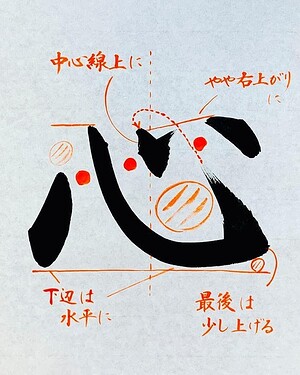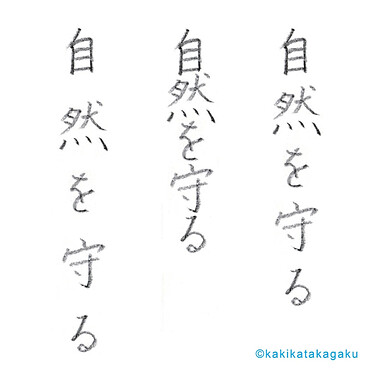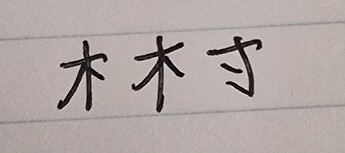How bad is your handwriting?
One fairly common post I see online from people learning Japanese is “How good is my handwriting?”, and then a picture of some carefully copied kanji characters.
One thing that very often comes up in that sort of thread is stroke order. Stroke order certainly is important and interesting(?). However, I want to discuss something different today. I want to discuss balance.
Balance and Blank Space
Forgetting slightly wonky stroke order or the occasional unthinkingly copied computer font (which perhaps I will discuss a different time), the largest culprit for “non-native” looking handwriting is balance, size, and use of blank space.
Now, don’t get me wrong, most natives have pretty shoddy handwriting. Not everyone in Japan is a 書道 (しょどう・calligraphy) master, but natives will write in such a way that the size, shape, and spacing of characters are (somewhat) clearly delineable. Meaning, native handwriting at least follows the logic of how characters are meant to look, even if they don’t always live up to the ideal. A learner’s messy handwriting and a native’s messy handwriting can be quite different.
Below is a very typical way that spacing is shown/taught to students taking 書道 classes in school, sourced from this blog:
The main thing I want to focus on here is the little circles with the lines through them. This negative space, which is sometimes called 間 (ま) in the context of Japanese aesthetics, is very important. In the most practical terms, it can help to imagine that you are drawing the lines around the negative space. So rather than drawing the lines you are actually demarcating the negative space, with the space giving form to the lines just as much as the lines give form to the space.
This can also be called 余白 (よはく・white space/margin). Below is another typical example from this blog:
(Keep in mind that the above examples are ideal examples in calligraphy, not how typical handwriting would look)
Things Fall Apart (ゲシュタルト崩壊)
Now the previous section may have felt obvious. It is pretty clear that if the lines or parts of a character are drawn unevenly then they will look off. This brings me to what I think the main culprit of “non-native” looking handwriting is: poor balance, size, and use of blank space at a sentence level.
Whilst it can be hard to get to grips with characters at an individual level, it is when they are all thrown together in a sentence that the issues become clearer. The most basic issue is having characters being too bunched up or too spread apart. Below is an example from this blog:
The far left sentence is too spread out and the central one is too bunched up.
Which leads us to ゲシュタルト崩壊 (げしゅたるとほうかい). This is ‘Gestaltzerfall’ in German or ‘Gestalt (shape) decomposition’ in English. In general, this term refers to when one fails to recognise a whole as you can only see it as its constituent parts. A fairly similar phenomenon is ‘semantic satiation’, where seeing or hearing the same word repeatedly makes it lose its meaning.
In relation to kanji, ゲシュタルト崩壊 refers to not being able to see a kanji as a “whole” and mistaking it for its parts. This happens especially when the balance of kanji both individually and then next to each other are off, so your brain can’t clearly delineate what is meant to be a single kanji or not.
Below I’ve scribbled a couple of examples (in my own bad handwriting but with some deliberate spacing issues) which show this point. First, we have a person’s name, which I have written with exaggeratedly poor spacing:
Can you read it? It doesn’t say 木木寸, if that helps.
It actually says...
木村 (きむら) - I had a student with this name once I swear he wrote it exactly like this, which made me scratch my head the first time I saw it.
Second, we have a normal word which is written a bit more fairly.
It kinda looks like 言式馬㑒 but…
It says...
試験 (しけん)
So What’s the Point?
It is very common for people to drill only individual kanji or, perhaps, words when learning to handwrite Japanese. Although stroke order is important, it may be more useful to focus on balance and spacing, not only at an individual kanji level but a whole word and sentence level. Stroke order is not so complex but balance is pretty tough to get right, even for some natives. As a tip, using grid paper or 原稿用紙 (げんこうようし・Japanese gridded writing paper) will help.
My handwriting is bad in English and Japanese so I think I’m a lost cause in any language 
My English handwriting for reference (written as I'd write notes for myself)
But I wonder if any of you guys find keeping a good balance difficult when writing kanji? Is your native language handwriting better than Japanese? Or even the other way round?







